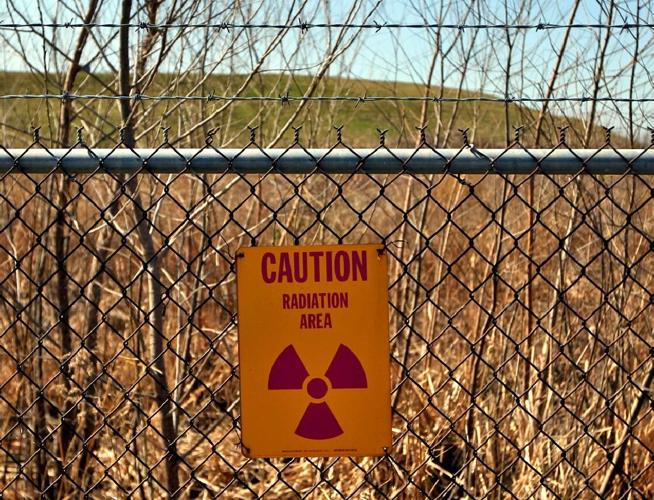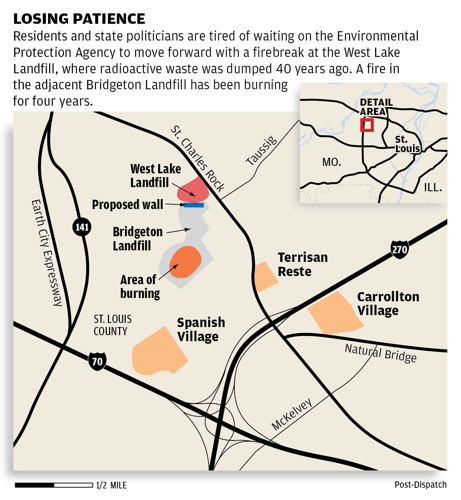After 25 years of failing to clean up the radioactive West Lake Landfill in Bridgeton, the U.S. Environmental Protection Agency should be fired from the job, according to Missouri’s congressional leaders.
Federal legislation introduced Thursday by senators Roy Blunt and Claire McCaskill and representatives Ann Wagner and William Lacy Clay would transfer oversight of the landfill from the EPA to the U.S. Army Corps of Engineers, which handles the cleanup of other nuclear waste sites around ӣ����Ƶ.
“The EPA’s unacceptable delay in implementing a solution for the West Lake landfill has destroyed its credibility and it is time to change course,” said Blunt in a statement.
The move could prove to be a hollow victory for the landfill’s neighbors who have pushed the government to make the switch. Representatives for the Army Corps have previously said the agency does not have the money to cover the upfront cost of cleanup at West Lake.
People are also reading…
Rene Poche, a spokesman for the corps, said in an interview Thursday that “we’ll do what Congress directs us to do.”
The two agencies handle the funding of toxic sites differently. The EPA generally gets money from responsible parties before the cleanup starts, and the Army Corps usually gets reimbursed after finishing the work.
Russ Knocke, spokesman for the landfills’ owner Republic Services, said in a statement that Republic opposed a transfer of control to the corps because it “would add more delays to a decision and permanent solution for West Lake. ... Going back to the drawing board on investigation and design work on a site with decades of data and study is not the answer. It would be a setback for a community that’s tired of waiting.”
Area residents said they trusted the corps to move more quickly to remove the waste and prevent the spread of a fire that has smoldered underneath the adjacent Bridgeton Landfill for the last five years. The corps does consult with the EPA on some issues at the site including plans for a firebreak to prevent the spread of the underground fire.
In recent months, the EPA has pledged to have a cleanup plan proposal by the end of 2016.
The corps handles the ongoing cleanup of other radioactive waste sites around ӣ����Ƶ, including Coldwater Creek in north ӣ����Ƶ County. The waste includes the byproducts of the Mallinckrodt chemical company’s uranium processing through the government’s atomic bomb program in World War II. The government stored the waste near the airport, where it contaminated the creek that runs from St. Ann to the Missouri River.
After the government sold the waste, a private contractor hauled thousands of tons to West Lake in the 1970s. The responsibility for cleanup landed under the EPA’s Superfund toxic site program in 1990 because the government was not considered the primary source of the landfill’s contamination. A 2008 plan for putting a soil cap over West Lake was rejected by the community, and the EPA has said a revised solution will announced by the end of next year.
The corps is responsible for the ongoing cleanup of the airport sites and Coldwater Creek, which has been linked to radioactive materials found in some backyards and parks in Hazelwood.
This week, the federal Agency for Toxic Substances and Disease Registry announced it would study the high rates of cancers in North County and a potential connection to exposure to the creek. Missouri health officials had asked for federal assistance after a state report in 2014 report showed high rates of leukemia, and breast, colon and other cancers in the areas surrounding the creek.
Starting next year, the federal scientists will evaluate the health effects of living near the contaminated creek. Current and former residents have taken their own surveys and found unusual numbers and types of diseases, including 48 cases of rare appendix cancers in the area.
“They’re listening,” said Jenell Wright, who grew up in Florissant. “They are going to carefully review and assess the situation that we feel has occurred to our health because of being located near nuclear weapons waste for decades that we didn’t even know about. We’re hopeful they will have ideas and recommendations that can help the people who’ve been affected.”













